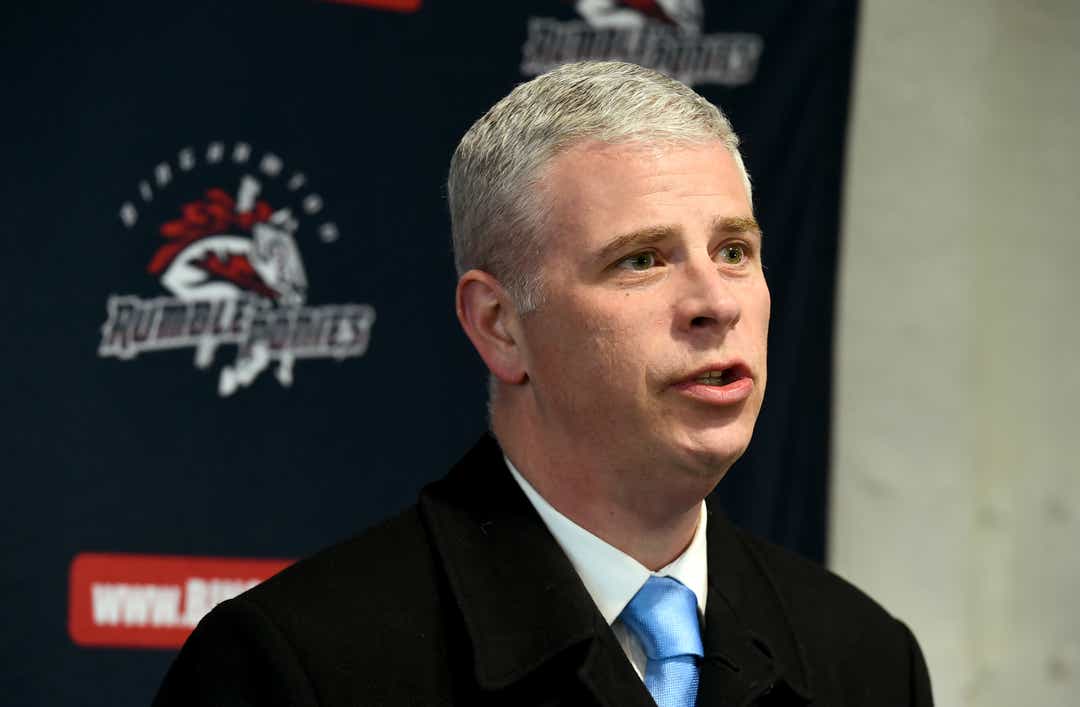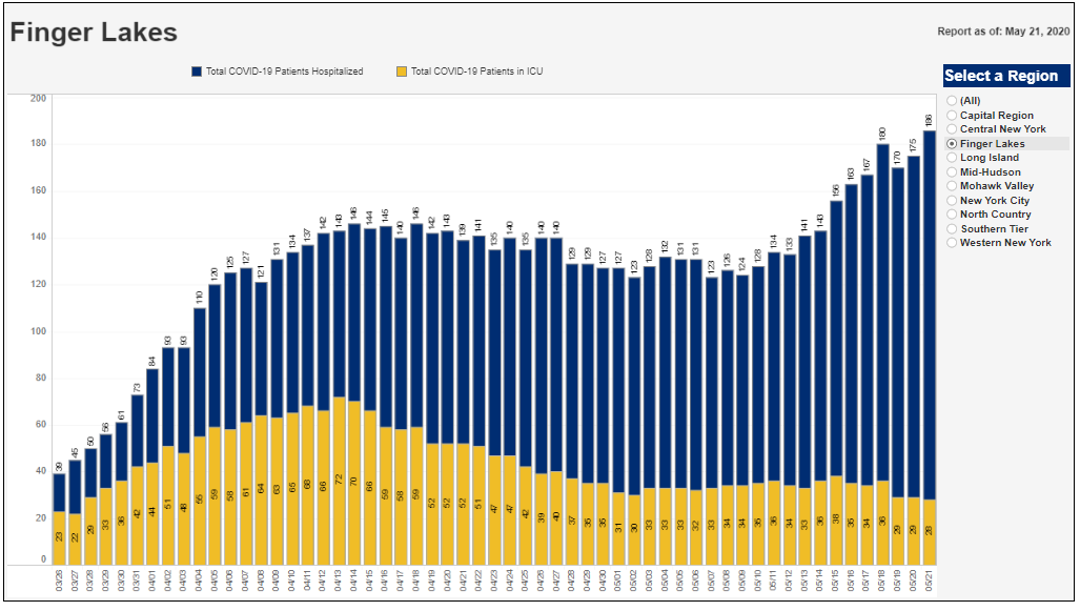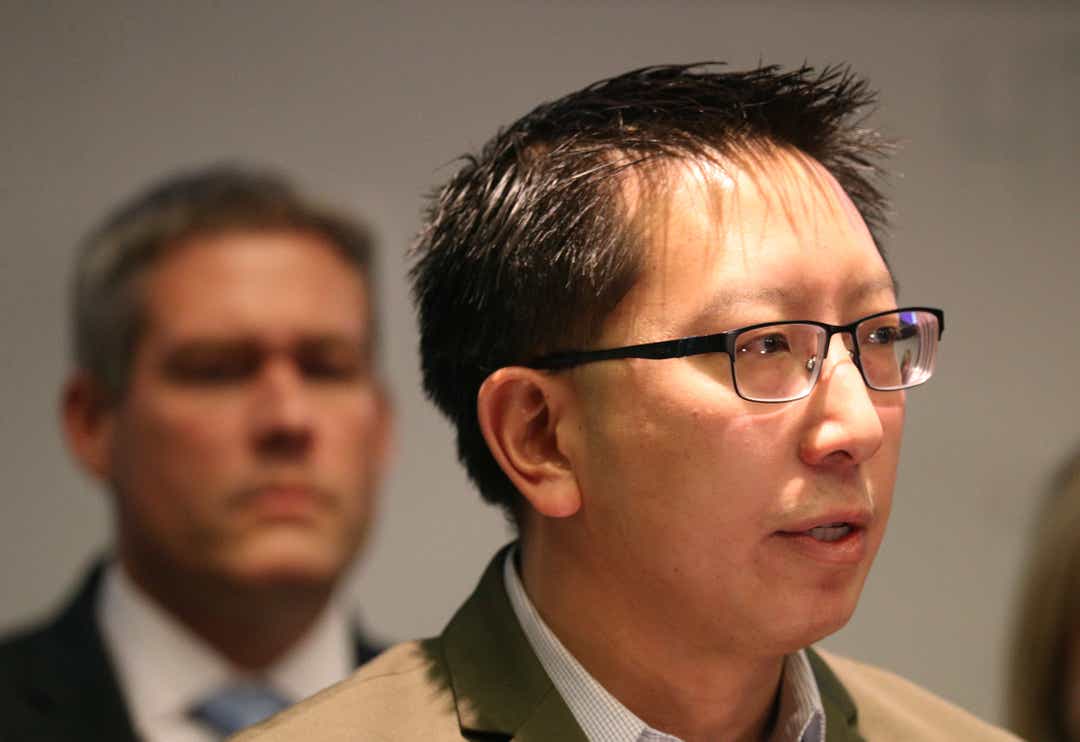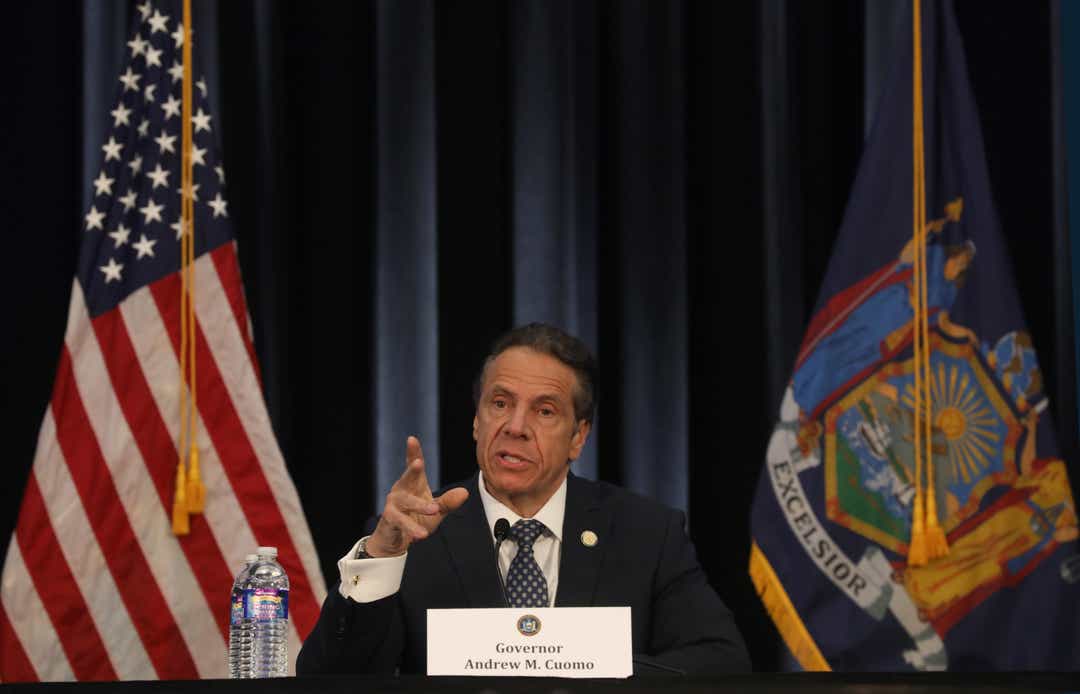ALBANY – The number of people hospitalized with the coronavirus is on the rise in three key upstate New York regions that already started lifting virus-related restrictions on businesses and their workers.
The Finger Lakes, Mohawk Valley and Central New York were all at or near their all-time high in current COVID-19 hospitalizations as of Friday, with each region showing a steady uptick that has persisted for more than a week, according to state Department of Health data.
The regions, which began easing shutdown measures May 15, pose a significant test for Gov. Andrew Cuomo and panels of local leaders known as Regional Control Rooms, whom the governor appointed to monitor daily COVID data and recommend whether to slow down or stop the reopening process.
So far, local leaders say the situation on the ground doesn't represent a dreaded COVID surge: An increase in testing capacity and a recently changed state rule regarding nursing home residents have essentially inflated the numbers, they claim.
And Cuomo himself has not sounded the alarm, insisting the increase in hospitalizations has nothing to do with easing shutdown rules across almost all of upstate.
But the data still raise the question: What would it take for Cuomo to make the extraordinary and politically difficult decision to stop or slow down a region's reopening after it already started?
"To be hospitalized, that means you had to get the virus," Cuomo said Wednesday during his daily coronavirus briefing. "It had to incubate. You had to get symptoms. You had to get very ill. And then you go to the hospital."
He continued: "There’s about a two-week lag on the hospitalization rate. So by definition, it couldn’t be linked to the reopening, but those are the data that we will be looking at."
More: New York coronavirus reopening: Why can't my region open up yet?
More: Hudson Valley and Long Island could start to reopen businesses next week, Cuomo says
Hospitalizations drive New York's metrics

Cuomo implemented a broad stay-at-home order, known as NY on Pause, on March 22.
It came as the coronavirus continued its rapid spread across the state. The virus has killed more than 23,000 New York residents, the vast majority of whom lived in New York City and its suburbs.
The order prevented all in-person operations at nonessential businesses while encouraging residents to stay home as much as possible.
To start reopening, Cuomo required each of the state's 10 regions to hit seven key metrics designed to show the spread of COVID-19 had slowed to a manageable rate.
Of the seven metrics, five were tied to hospitalizations. Regions were required to show total hospitalizations and hospital deaths were in a sustained decline or hadn't spiked, while the rate of new hospitalizations had to be below 2 for every 100,000 residents and more than 30% of hospital and ICU beds had to be available.

Five regions — the Finger Lakes (which includes Rochester), Southern Tier, Mohawk Valley, Central New York and North Country — met those criteria and were allowed to reopen construction, manufacturing and limited retail operations May 15, the first day the state allowed.
The Capital Region and Western New York met the criteria the next week, but only after the state reset the date for calculating spikes in hospitalizations and deaths — a key change that allowed the region to open up as many as 10 days before they otherwise would have been eligible.
Three regions — New York City, the Mid-Hudson and Long Island — hadn't met the reopening criteria as of Friday. But Cuomo said Friday that Long Island the Hudson Valley were expected to get there next week.
More: New York's unemployment rate hits 14.5% in April
More: New York beach openings: These are the beaches that will open Memorial Day weekend
Control Rooms named, but have little authority

Cuomo has laid out a four-phase reopening plan for each region, with each phase bringing on more businesses and industries that are allowed to open their doors with proper social-distancing and density-reduction measures in place.
He has said each phase will last at least two weeks. But he has also formed what he calls Regional Control Rooms to monitor the COVID data and alert the state if there is cause for concern.
Each Control Room is chaired by a Cuomo loyalist — former Lt. Gov. Robert Duffy in the Finger Lakes and DEC Commissioner Basil Seggos in the Southern Tier, for example — and includes various local government, business and health leaders.
"The Control Rooms are really supposed to look at the data and make sure we're meeting the criteria to open and maintain those numbers going forward," said Oneida County Executive Anthony Picente, a member of the Mohawk Valley Regional Control Room.
Broome County Executive Jason Garnar, a member of the Southern Tier Regional Control Room, said the panel meetings give local officials to ask questions and let the state know of any areas of concern.
"It's an opportunity for us to pitch all those questions to the state," Garnar said. "If this is a war, we're kind of like the cavalry — we're the boots on the ground and we can tell the state what's going on."

More: When will New York's casinos reopen? What Cuomo and the betting halls are saying
Those Control Rooms, however, have little by way of actual authority, even though Cuomo has repeatedly suggested they have the ability to "turn the valve" on or off during the reopening process.
Reporters for the USA TODAY Network New York requested access to Control Room meetings in five different regions this week. Each time, the reporters were denied or referred to Cuomo's office.
Shoshanah Bewlay, executive director of the state Committee on Open Government, said the Control Rooms appear to be "advisory in nature," which means they can meet in private.
If they had actual decision-making authority, their meetings would be subject to the state Open Meetings Law, which would allow the public to listen in.
It all means Cuomo — not the regional panels — has the final call on whether to stop a region's reopening progress.
Cuomo said Wednesday the data would have to show an increase in community spread for the state to step in.
"If you see a shift, you may have a cluster, you may have a hot spot or you may not have a hot spot and it may be just a dramatically increased community spread," Cuomo said. "And community spread — that would trigger a more systemic issue."
More: Coronavirus in New York: Interactive map of cases and deaths by county
More: Reopening: Most Americans fear second wave of coronavirus: Marist Poll
Hospitalizations were increasing at time of opening

Despite getting the green light to begin reopening, state data shows current COVID-19 hospitalizations were increasing in the Finger Lakes and Central New York (home to Syracuse) before they began the reopening process.
The Finger Lakes, for example, saw the number of current hospitalizations increase in six of the eight days leading up to May 15, rising from 123 on May 7 to 156 on May 15 — a 27% increase in a week's time, according to state data.
In Central New York, current hospitalizations increased from 31 on May 1 to 65 on May 15, a 110% increase.
The daily spikes were small enough to keep the regions eligible for reopening, and they represent a small portion of the state's total COVID hospitalizations, which were at 5,187 as of Wednesday and driven largely by downstate.
Hospital capacity remains strong in both regions, too.
But the regional increases have largely continued since May 15, with the Finger Lakes reaching an all-time high of 186 on Thursday. Central New York hit an all-time high of 84 on Tuesday, while the Mohawk Valley matched a high of 50 on Wednesday.
"The Finger Lakes, in particular, you have a clear-as-day trend," said Bill Hammond, director of health policy at the Empire Center, an Albany-based think tank that analyzed the recent hospital data.
"I have to say, I'm puzzled that you would move ahead under those circumstances."
More: NY colleges plan fall reopening without clear state direction. What they are saying
More: Coronavirus in New York: Interactive map of cases and deaths by county
How locals explain the increases

Local leaders say there are two ways to explain the increase. Neither suggest COVID is actually surging, they claim.
Michael Mendoza, Monroe County health commissioner, pointed to a significant increase in testing capacity, allowing the Finger Lakes region to test more people for COVID — including people who were already in the hospital and had not tested positive previously.
He also pointed to a May 10 decision by Cuomo preventing hospitals from sending nursing home residents back to their home facility until they have tested negative for COVID-19.
That means residents who would have been sent home earlier under the previous rules now are remaining in the hospital for a longer stay, keeping the COVID hospitalization numbers up despite some patients having already resolved their symptoms.
Hospitals across the state, including the Albany Medical Center, have raised similar concern.
"Overall, we have a good explanation for all the new cases," Mendoza said Thursday during a forum hosted by WXXI in Rochester.
More: Small religious gatherings will be allowed in New York. Here are the new details
More: Memorial Day: New York to allow small ceremonies, vehicle parades despite coronavirus
Cuomo administration says numbers look good

Cuomo seemed largely unconcerned when asked about the increases Wednesday.
He emphasized that hospitalizations are a "lagging" indicator, meaning they give a more accurate picture of the COVID spread two weeks ago because it takes time for the virus to incubate and cause symptoms that require hospitalization.
Jim Malatras, a top Cuomo adviser and president of SUNY Empire State College, said the state is monitoring "real-time" indicators in the regions that have already opened to get a better sense for the current situation.
Among them are the number of new patients walking into hospitals — as opposed to total hospitalizations, which includes patients with longer stays — and the rate of positive COVID tests.
Both of those metrics were down in the Finger Lakes and Central New York, he said.
"As regions are reopening, we’re going to take a broader look at new infection rates, new positive tests because that’s real-time," Malatras said.
"We don’t want to be on a lag anymore. The reopening was: What were the problems that we have? How did those dissipate or not dissipate to reopen? Now that we’ve reopened regions, let’s get the diagnostic testing right away."
From Monday through Wednesday, 5,189 Monroe County residents were tested for COVID-19, according to state data. Of those, 227 — or 4.3% — tested positive.
Since the beginning of the pandemic, about 6.7% — or 2,530 of 37,819 — of Monroe County residents' tests came back positive, according to the state's data as of Wednesday. That's down from 10% at the start of the month, driven in part by the state and county significantly expanding the number of tests it performs each day.
Monroe County is the population center of the Finger Lakes.
Mendoza said he's comfortable with where the county is at.
"In spite of the numbers that may look concerning at first, I think overall our community is doing better than it was even a week or two weeks ago," he said.
More: Restaurants and bars in New York want to open sooner than planned. Here’s how they'd do it
More: 'Totally different': New York tourist spots brace for uncertain summer. What we found
Jon Campbell is a New York state government reporter for the USA TODAY Network. He can be reached at JCAMPBELL1@Gannett.com or on Twitter at @JonCampbellGAN.
Support local journalism
We cover the stories from the New York State Capitol and across New York that matter most to you and your family. Please consider supporting our efforts with a subscription to the New York publication nearest you. Check out the latest offer.
"Shut" - Google News
May 23, 2020 at 03:15AM
https://ift.tt/2ANFvTe
Coronavirus: What will it take to shut down a New York region after opening? - Democrat & Chronicle
"Shut" - Google News
https://ift.tt/3d35Me0
https://ift.tt/2WkO13c
Bagikan Berita Ini














0 Response to "Coronavirus: What will it take to shut down a New York region after opening? - Democrat & Chronicle"
Post a Comment